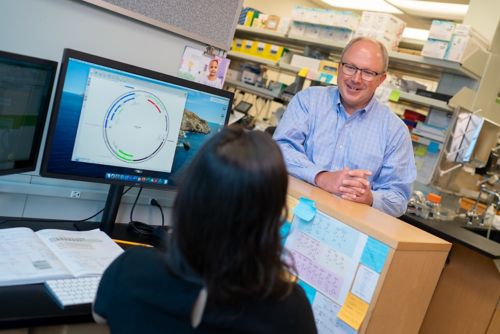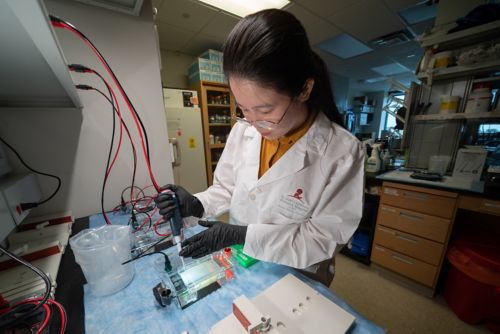St. Jude Family of Websites
Explore our cutting edge research, world-class patient care, career opportunities and more.
St. Jude Children's Research Hospital Home

- Fundraising
St. Jude Family of Websites
Explore our cutting edge research, world-class patient care, career opportunities and more.
St. Jude Children's Research Hospital Home

- Fundraising
David Rogers Lab
Tackling anti-fungal drug resistance using genome-wide technologies and molecular biology techniques in large collections of clinical isolates
About the Rogers Lab
Fungal infections are recognized as an increasing clinical threat, especially to vulnerable populations. Three separate classes of antifungal agents exist for the treatment of serious fungal infections, but each has its own limitations. Our laboratory is interested in understanding how fungal pathogens mount resistance to available antifungal agents, and how we can leverage this understanding to optimize treatment. We use a multi-faceted approach, and state-of-the-art technology, to tackle antifungal drug resistance in critical patient populations.

Our research summary
Our laboratory is interested in understanding how fungal pathogens, particularly those that impact immunocompromised patients, mount resistance to existing antifungal agents. One of the challenges we have as clinicians is that there are only 3 classes of antifungal agents available to treat severe, life-threatening infections. With no new antifungal agents on the horizon, and resistance mechanisms increasingly emerging, our team recognizes a critical need for discovery in this space. Our work is funded by multiple grants from the NIH and focuses specifically on resistance to front-line therapies for Candida and Aspergillus species. Ultimately, we hope to develop novel therapeutic strategies to preserve the utility of existing antifungal agents and lead the way to optimized selection of antifungal therapy.
Candida albicans
Candida albicans is the most common fungal pathogen in man. In recent decades resistance to front-line antifungal therapy has emerged, particularly in immunocompromised patient populations. Through a long-standing collaboration with investigators at the University of Würzburg, Swansea University, and the University of Missouri – Kansas City, we are dissecting the molecular mechanisms of antifungal resistance in C. albicans to improve the treatment of infections due to this yeast and using it as a model to understand antifungal resistance in other fungal pathogens.

Candida glabrata
Candida glabrata is a fungal species found commonly in patients with systemic infections in the ICU and is inherently resistant to one of the existing classes of anti-fungal agents. To understand how we might improve clinical treatment, through a collaborative effort with investigators at the University of Iowa, we are dissecting the pathways essential for resistance and determining whether they are drug targetable. It is our hope to reclaim a whole class of agents by defining, and manipulating, these mechanisms.

Candida auris
Candida auris has recently been classified by the CDC as an urgent antibiotic resistant public health threat. There are examples of single- and multi-drug resistance within this species, making it a significant clinical challenge. In a collaborative effort between St. Jude, the Broad Institute, and the CDC, our team is working to uncover the genetic and molecular mechanisms of resistance. The emergence of this pathogen aligns with advances in technology and access to clinical isolates. This has facilitated large scale profiling of whole genome sequencing data and application of CRISPR/Cas9 approaches for refined gene editing in previously intractable models.
Aspergillus fumigatus
Aspergillus fumigatus is one of the most common aspergillus species to cause disease in immune-compromised individuals. It also demonstrates emerging resistance to an historically superior class of antifungal agents. While overexpression of efflux pump and mutations in the gene encoding the drug target contribute to resistance, much of the antifungal resistance of A. fumigatus remains unexplained. Using whole genome sequencing of clinical isolates, we are working closely in collaboration with investigators at the Broad Institute and the Universty of Tennessee Health Science Center to understand the molecular mechanisms of resistance more thoroughly and hopefully develop new therapeutic approaches.
Our diverse team of staff scientists, post-docs, and graduate students is made up of clinical pharmacists, molecular biologists, microbiologists, and biochemists who are dedicated to tackling the challenge of antifungal resistance. They bring their collective clinical perspective, technical expertise, and scientific training together to answer important clinical questions using a truly translational approach. Our laboratory is also committed to training the next generation of pharmaceutical and biomedical scientists within the fields of medical mycology and antifungal therapeutics.

Selected Publications
Contact us
P. David Rogers, PharmD, PhD, FCCP
Member, St. Jude Faculty
Chair, Pharmacy and Pharmaceutical Sciences
MS 313, Room I5112
St. Jude Children's Research Hospital

Memphis, TN, 38105-3678 USA GET DIRECTIONS
